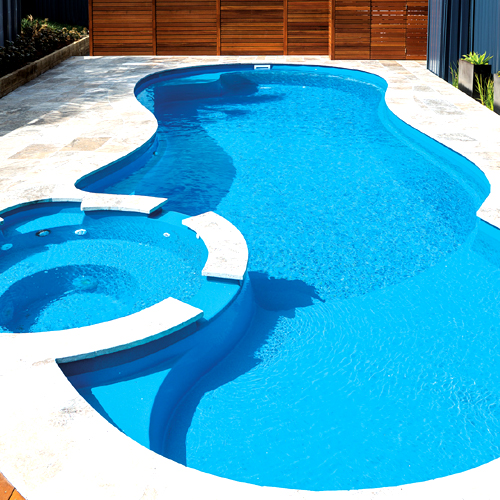Over the past five years, the U.S. pool and spa
industry has become increasingly interested in using ozone as a supplemental
disinfectant to traditional chlorine and bromine-based water treatment. The
high bather loads of large, recreational water parks have challenged
traditional chemical treatment systems in providing exceptional water
clarity with minimum chlorine odor and bather discomfort. Adding fire to
this interest is the recent press given to the chlorine resistant,
pathogenic parasites (Cryptosporidium parvum) and bacteria (Legionella
pneumophila) that exist within many of our communities municipal water
systems.
Today, most of the large commercial pool designs include Ozonation system
as an integral part of the pool's water treatment system. However, ozone
treatment approach can vary widely in design and effectiveness. A good
design approach is to model the ozone treatment system after other
successful operating systems, keeping in mind your water quality goals and
the differences as well as the similarities between your pool and the ozone
treated pools you are studying. These differences may include pool location
water temperature, water quality and bather load. When an ozone treatment
program is properly designed, it should provide some or all of the following
benefits:
Reduced Chemical Usage
When ozone is properly applied it can
demonstrate chemical savings in two ways. First, if ozone is sized and
integrated into the treatment system properly, it will act as the primary
oxidizer and disinfectant. This reduces the amount of chemical (chlorine or
bromine) needed to maintain the free halogen residual required by state law.
Second, when ozone is used in conjunction with sodium bromide, it has the
potential to regenerate spent bromine, thus reducing the sodium bromide feed
rate. Some facilities that use ozone and sodium bromide in this manner have
reported up to a 60 percent reduction in chemical usage.
Superior Disinfection
Ozone has been shown to be a superior
disinfectant to chlorine or chlorine-bromine treatments still used in many
U.S. pools and spas. Studies conducted under the guidance of Dr. Eugene
Rice. USEPA Office of Drinking Water Standards, show that the C.T value
[(Disinfectant concentration in mg/L) X (Contact time of disinfectant with
water)] of free chlorine for 99 percent inactivation of the Cryptosporidium
oocyst is 7,200, while ozone shows a much lower C.T value of 5-10. Ozone's
reaction against fecal coliforms is even more dramatic. Strains of E. Coli
bacteria exposed to a 0.1 mg/L residual of ozone are destroyed in less than
12 seconds.
To achieve disinfection in a swimming pool application, an applied ozone
dosage of 0.8 to 1.6 mg/L is usually sufficient to provide effective ozone
residual for inactivation of microbes and conversion of residual
disinfectants. The actual dosage and contact time required to generate a
disinfecting residual will depend upon the water quality and whether the
pool is utilizing chlorine or bromine to provide a residual pool
disinfectant. A minimum contact time of two minutes is usually sufficient
for microbe inactivation and disinfectant conversion.
Enhanced Bather Comfort
The addition of ozone to a swimming pool
treatment system has a dramatic effect on bather comfort. Compared to
chlorine treated pools, ozone fed pools are far ahead of chlorine injection
and dramatically reduces chemical consumption by destroying many of the
organics and microorganisms that react with chlorine. The lower chlorine
demand allows the pool operator to achieve disinfection with minimal
chlorine residual, thus reducing the strong chlorine odor associated with
indoor pools and minimizing the amount of chlorine off-gas-which may cause
considerable corrosion in swimming pool environments. When ozone is applied,
a free chlorine residual of 0.4 ppm is usually sufficient to maintain water
quality. When oxidizing organic material, if dosage and contact time are
sufficient, ozone will also break down chloramines- a major cause of pool
odors and bather discomfort- into nitrites and chlorides as shown below :
NH2Cl + 3O3 ==> 2H+ + NO3 + Cl-
Today, many pools and spas have turned to bromine as an alternate
disinfectant to chlorine because it is less irritating to the bathers' skin
and has a longer half-life than chlorine, and can be continually oxidized
back to its disinfecting form- hypobromous acid, after it has combined with
pool organics. When ozone and sodium bromide are initially placed together
in water at a pH above 7.0 the bromide ion is oxidized to form the
hypobromite ion, which quickly disassociates in a manner similar to
chlorine, forming hypobromous acid in equilibrium with hypobromite ions.
HOBr + H2O ==> (OBr) + (H3O) +
At a typical swimming pool pH of 7.2 - 7.8, this equilibrium is to the
left, providing sufficient hypobromous acid to react with microorganisms and
contaminants. As hypobromous acid oxidizes the organic pollutants, the
bromine is reduced to bromide ions. Ozone continually oxidizes these bromide
ions back to by pobromite ions. (OBr), which disassociate to form
hypobromous acid. HOBr / (OBr) + Organic pollutants ==> Br- Br- + O3
==> (OBr)-
(OBr)- + (H3O) + HOBr + H2O
Another example of ozone's ability to reactivate expended bromine is its
oxidation of the monobromamines, which are formed when bromine combines with
urea and other nitrogen compounds. The rapid oxidation of these amines into
nitrites and bromide ions (Five times the reaction rate of ozone and
chloramines) is followed by the further oxidation of the bromide ions to
form hypobromous and hypobromite ions (shown below)
NH2Br + O3 ==> NO3 + Br -
Br - + O3 ==> HOBr + (OH)-
H2O
This continual oxidation of the reacted bromide ion back to hypobromous
acid is one reason a bromine ozone treatment system is considered one of the
most cost effective ways to treat large recreational pools.
Exceptional Water Quality
When Ozone is applied to water, a side benefit
is an improvement in water clarity. A phenomenon called micro flocculation
occurs - a process in which some of the organic contaminants form a pin floc
that can easily be removed by an ozone resistant sand filter. Large,
commercial pools with high bather loads often rely on the microflocculation,
benefit of Ozone to reduce their dependence on chemical filter aids. The
exact dosage of ozone required to generate the pin floc will depend on the
water quality and the nature of the water's contaminants. If you are
considering adding ozone to an existing pool or spa or perhaps adding it to
an existing design for a new facility, it is important to realize that
ozone, by itself, is not a panacea for a poorly designed system. Good
filtration efficiency, adequate pool turnover rates, good pool hydraulics
and proper water chemistry are essential to achieve the benefits promised by
ozone Though no nationwide standards for ozone have been implemented, there
are some basic safety guidelines proposed by the USEPA as noted below :
Ozone Health And Safety
- The USEPA proposed human exposure limit to ambient ozone gas is 0.1
ppm for eight hours (time weighted) and 0.2 ppm for 15 minutes.
- Any Ozone residual in the contact vessel must be removed before it
returns to the pool since off gassing of ozone at the water surface can
pose a health hazard. Pools using chlorine as their residual
disinfectant may require the Ozonated water to pass through a granular
activated carbon (GAC) filter to remove the last traces of ozone. Pools
utilizing bromine usually will not require GAC removal of ozone. The
excess bromide ion and bromine compounds typically consume all of the
available ozone and returns as hypobromous acid to the pool.
- Systems using a full or side stream contacting system will require an
ozone destruct device to remove ozone from the contactors off-gas.
- An ambient air ozone monitor should be placed in the room with the
ozone generator. If an ozone gas leak occurs, the unit should alarm and
shut down the generator.
With the increasing regulatory emphasis on safety and environmental
friendly water treatment of swimming pool and spa, industry has growing need
for exceptional water quality, the use of ozone as an integral part of the
water treatment will continue to grow. Keep in mind that the lack of firm
guidelines in the United States has resulted in the installation of a
variety of ozone treatment systems with varying degrees of success. If you
are interested in pursuing an ozone treatment system for your facility, it
is always recommended you select a design team as well as an ozone equipment
manufacturer from those firms who possess a long history of successful ozone
applications. These companies will be able to provide the technical support
and service you want today and will be around when you look for service in
the years ahead.
Advantages Of Using Ozone For
Swimming Pools And Spas
- Water is odour free
- Water will not dry the skin and irritate the eyes
- Ozone will not produce THMs (Tri-Halo Methanes)
- Ozone will not bleach hair and bathing suits


